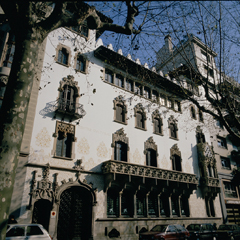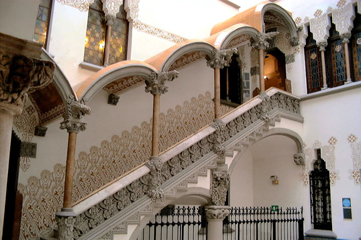City & Venue
Conference venue
This year the conference venue has been moved to Palau Macaya, a modernist building located near the center of Barcelona. La Caixa Foundation has lent this space for the fourth edition of Barcelona PR Meeting, as it did last year with Cosmocaixa.
PALAU MACAYA
Passeig de Sant Joan, 108
08037 Barcelona
Tel.: +34 93 457 95 31
Palau Macaya is located in Passeig de Sant Joan, next to Diagonal in a modernist mansion built between 1989 and 1901 by the architect Josep Puig i Cadafalch.
Since 1947, Palau Macaya has been connected to La Caixa Foundation, when it housed the first Educational Institute for deaf and blind people. Later, in the early 70s, it became a cultural center. The building was declared a Cultural Asset of National Interest by the Generalitat de Catalunya on 1976.


Since then, this architectural marvel has hosted a global program that fosters collaboration and synergies with structures and institutions of the realm of thought, the social sciences, environmental conservation and the search for sustainability.
How to get there?
Metro
Verdaguer. L4 (yellow) and L5 (blue)
Bus
Lines 15, 19, 33, 34, 43, 44, 50, 55 y B24
Stylish Barcelona
BCN Meeting PR #4 will be held in Barcelona, situated on the western Mediterranean and widely acknowledged
as one of the most beautiful and vibrant cities in Europe. Founded in Roman times Barcelona has preserved
an outstanding architectural heritage, notably in Gothic, Modernist and avant-garde styles.
Video: Some reasons to visit Barcelona
- Barcelona is the capital of Catalonia and the city of Modernisme with nine UNESCO World Heritage sites
- Barcelona is the best summer city according to followers of the Lonely Planet social networking websites (2011)
- Barcelona is the first city in the world to be certified by Biosphere as a sustainable tourist destination (2011)
- Barcelona Shopping Line is the ultimate in tourist shopping routes, with top international and local designer labels.
- Barcelona has the best Romanesque art collection in the world (MNAC museum)
- Barcelona has 21 Michelin stars
- Barcelona has 4.5km of beaches
Barcelona, Catalonia's capital is one of the foremost cities on the western Mediterranean. Founded in Roman times, it experienced periods of great economic and cultural brilliance in the Middle Ages and it wake of the Industrial Revolution (19th Century). It has preserved an outstanding architectural heritage, notably in Gothic, Modernist (Gaudí) and avant-garde styles. Barcelona has a unique, bustling, tree-lined promenade where its citizens gather in all their diversity. It is called the Rambla and stretches from Plaça de Catalunya to near the monument to Colombus. On it stand the Liceu, one of the Europe's most prestigious opera houses and the market of La Boqueria. It is also lined with popular newspaper kiosks and stalls selling flowers. Two of Barcelona's most important religious buildings are located in the districts of Ciutat Vella and La Ribera: the Cathedral, built in Gothic times, and the basilica of Santa Maria del Mar, one of the most outstanding examples of Catalan Gothic style.
Barcelona is also the undisputed capital of Modernist architecture and one whole district –the Eixample. Was built according to MKodernist tenets. Passeig de Gràcia is the street with the largest concentration of major Modernist buildings: casa Batlló and La Padrera by Gaudí, Casa Ametller by Puig I Cadafalch, and Casa Llaó Morera by Domènech i Montaner.
For further information visit the Barcelona Turisme Website.
About Catalonia
Catalonia is a small country, in terms of size. But its personality, shaped by over a thousand years of history,
and its distinct culture and language, has made it both rich and great.
Catalonia lies in the north-eastern Iberian Peninsula. It has over seven million inhabitants and occupies an area comparable to Belgium, the Netherlands or Switzerland.
Video: Some information about Catalonia
Catalan language
Catalonia's own language is Catalan. This has been the case since the 12th century. When democracy was restored in 1979, Catalan and Spanish were both recognized as official languages in Catalonia. The origins of the Catalan language date back to the early Middle Ages. Despite periods of prohibition and repression, the majority of Catalans still use it today.
Catalonia's heritage
The castells (human towers) and the Mediterranean diet, registered as intangible cultural heritage by UNESCO.
Dalí and the Surrealism
Salvador Dalí (Figueres, 1904 - 1989) was an artist who defies classification. He was a unique figure in Surrealism, to which he contributed the paranoiaccritical method, and was one of the first to make his life and work a marketing commodity. Dalí's work in Catalonia is housed in the main in the Teatre-Museu Dalí in Figueres, in the castle in Púbol and the Casa-Museu Salvador Dalí overlooking the bay of Portlligat in Cadaqués.
Pau Casals, the great cellist
Pau Casals (El Vendrell, 1876 - Puerto Rico, 1973) is internationally one of the best known Catalans. Listening to Casals play a suite by Bach is an unforgettable experience. His name is still linked with that of the town where he was born, El Vendrell (Costa Daurada), thanks to Vil·la Casals (his home and now a museum), to the house where he was born, and to the Auditori Pau Casals and its programme of music dedicated especially to Catalan performers and composers.
Catalonia is Gastronomy
Guides and critics all over the world consider that Catalan cuisine is currently experiencing a veritable "golden age". Catalan restaurateurs include some of the world's most prestigious names, such as Ferran Adrià, Joan Roca, Carme Ruscalleda and Carles Gaig, all veritable geniuses of avant-garde cuisine.
Wine and cava
Wine has been produced in Catalonia since the time of the Romans. Catalonia encompasses a varied range of DO appellations: Catalunya, Costers del Segre, Tarragona, Pla de Bages, Costa Brava, Allella, Conca de Barbera, Montsant, Terra Alta, Penedes, Priorat.
Catalonia is also the heartland of Cava. Cava is Catalonia's very own sparkling wine, made using the 'Champagne method' and a delicious version of its French cousin. It is extremely popular in Barcelona, and indeed the rest of Spain, thanks to the numerous vineyards in the region owned by top wine-makes such as Codorniu, Torres and Freixenet.
Cava is produced in varying levels of dryness, according to the amount of sugar used in the fermentation process. These are: brut nature, brut (extra dry), seco (dry), semiseco (medium) and dulce (sweet). According to Spanish law, Cava can be produced in six wine regions in Spain. 99% of Cava is made in the Penedès region of Catalonia.
For further information about Catalonia, visit the Catalonia Tourist Information Website.



